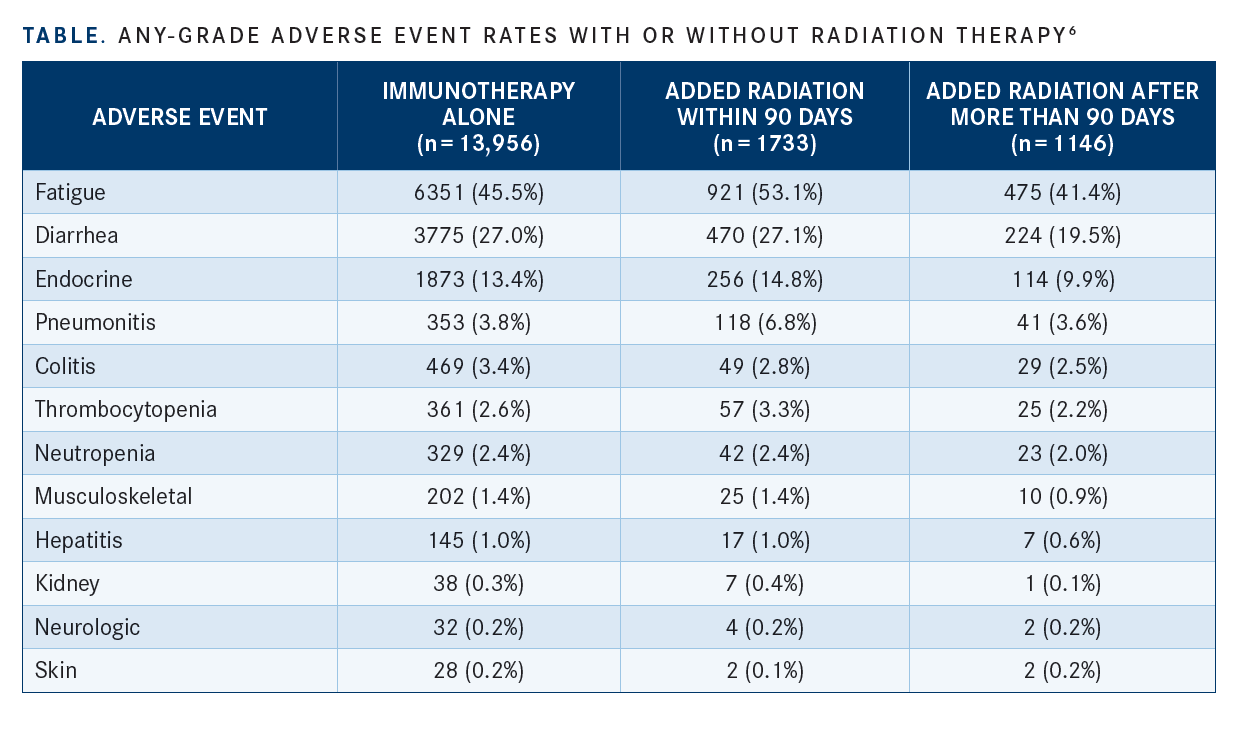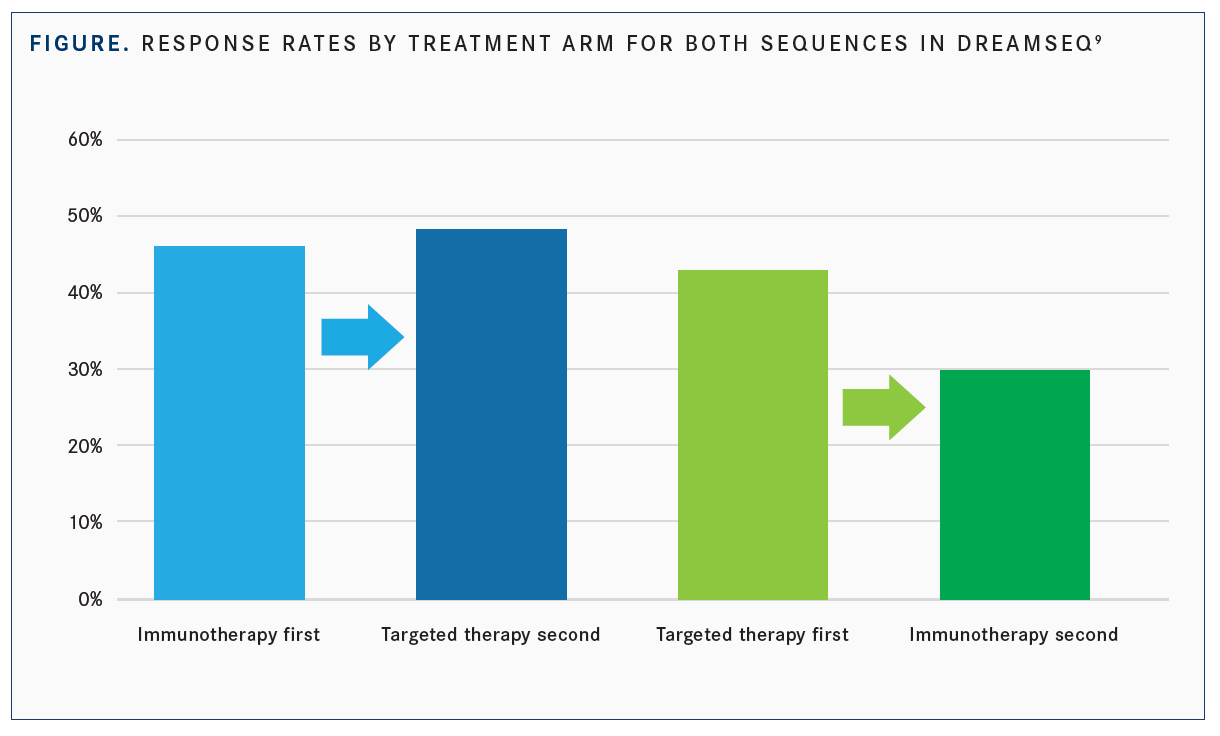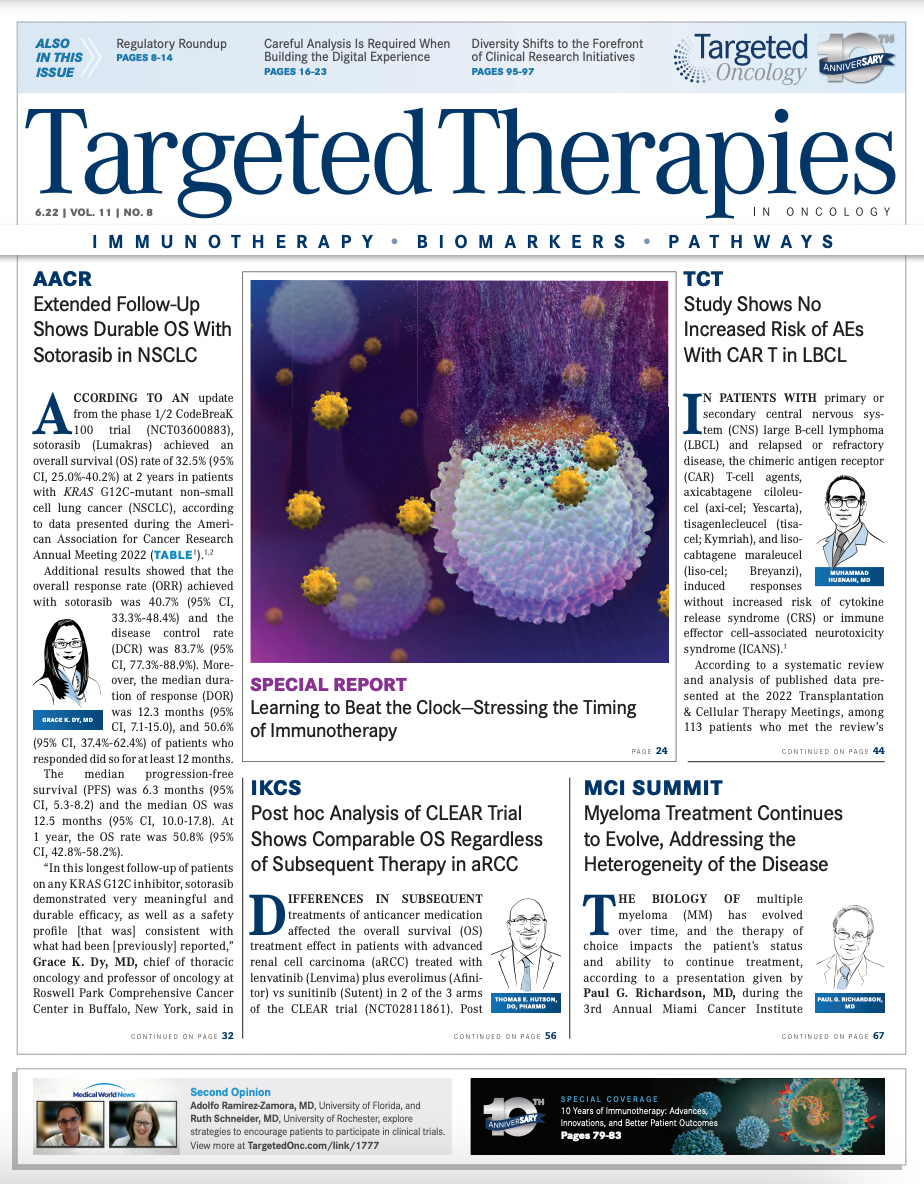Learning to Beat the Clock—Stressing the Timing of Immunotherapy
Most studies of how timing affects immunotherapy efficacy have defined “timing” relative to other treatments, but some research has investigated the impact of giving patients immunotherapy at different times of day.
Paolo A. Ascierto, MD

When immunotherapies were first studied in patients with cancer, a minority of recipients experienced robust responses to single agents after progressing on other therapies, but most did not respond at all. Subsequent trials have seen far higher response rates, in part because of better patient selection and in part because researchers keep learning more about a surprisingly important aspect of every treatment protocol: timing.
A growing body of evidence suggests that giving immunotherapy at the right time relative to other treatments (or even just giving them at the right time of day) can increase efficacy, reduce adverse events (AEs), or both.
The efficacy of immunotherapy hinges both upon tumor biology—antigen expression, microsatellite instability, mutational burden, tissue heterogeneity—and upon the patient’s immune system. Both factors change as cancers progress and patients undergo treatment, however, which is why timing can have such a large effect on immunotherapy efficacy.1
“From what we have seen from clinical study and the real world, immunotherapy typically works better if you give it at the beginning, before patients have developed resistance to other treatments,” said Paolo A. Ascierto, MD, director of the Unit of Melanoma, Cancer Immunotherapy and Innovative Therapy, at the National Tumor Institute Fondazione G. Pascale in Naples, Italy.
“Immunotherapy also tends to work better in combinations than as monotherapy,” Ascierto added. “Combinations can increase response rate and overcome resistance, though often at the price of higher [adverse] effects.”
Specifics naturally vary by tumor type, which is why dozens of trials are underway to determine optimal treatment sequences for particular patients with particular tumors. Previously reported studies have already changed standards of care and those standards continue to receive frequent updates as new results trickle in.
Radiation
Preclinical work that began shortly after the approval of the first immune checkpoint inhibitors (ICIs) indicated that adding radiation to immunotherapy could boost response rates. Radiation damages cancer cells in ways that expose tumor-specific antigens and thus, these studies found, makes them visible to the immune system and primes cytotoxic T cells to attack, which complements the effect of immunotherapies.2
A number of clinical trials have found the predicted synergies with radiation or chemoradiation in a variety of immunotherapies.
In a phase 1 clinical trial (GOG-9929; NCT01711515) of patients with node-positive cervical cancer, combined chemoradiation and ipilimumab (Yervoy) significantly increased both central and effector memory T-cell populations.3 The 12-month overall survival (OS) rate was 90% and the 12-month progression-free survival (PFS) rate was 81%. T cells expressing programmed celldeath protein 1 (PD-1) increased after chemoradiation and levels were sustained with ipilimumab.
In a pooled analysis of 148 patients with metastatic non–small cell lung cancer (NSCLC), 76 of whom had been randomized to receive pembrolizumab (Keytruda) monotherapy and 72 who had been assigned pembrolizumab plus radiotherapy, the median PFS was 4.4 months with pembrolizumab alone vs 9.0 months with pembrolizumab plus radiotherapy (HR, 0.67; 95% CI, 0.45-0.99; P = .045). Median OS was 8.7 months with pembrolizumab vs 19.2 months with pembrolizumab plus radiotherapy (HR, 0.67; 95% CI, 0.54-0.84; P = .0004).4
Among 709 patients with stage III NSCLC who received chemoradiation followed by either placebo or durvalumab (Imfinzi) in the phase 3 PACIFIC trial (NCT02125461), the median PFS from randomization was 16.8 months with durvalumab vs 5.6 months with placebo (HR, 0.52; 95% CI, 0.42-0.65; P < .001). The 12-month PFS rate was 55.9% with durvalumab vs 35.3% with placebo, and the 18-month PFS rate was 44.2% vs 27.0%. The response rate was higher with durvalumab than with placebo (28.4% vs 16.0%; P < .001), as was the median time to death (23.2 months vs 14.6 months; P < .001).5
Using ICIs in conjunction with radiation also appears to be well tolerated. A pooled analysis from the FDA database of 68 such trials found that patients who received ICIs within 90 days of radiation had similar rates of AEs to patients who received immunotherapy alone, with an average absolute difference of 1.2% in rates of any-grade AEs between those who received radiotherapy and immunotherapy and those who received immunotherapy alone (TABLE), and even less for grade 3-4 AEs.6
As trial-supported combinations of radiation and immunotherapy become standard of care for some patients, researchers are working to further improve results by testing radiation with a wider variety of immunotherapies and fine-tuning the timing of the radiation and the medication. Early-stage work has investigated the effect of pairing radiation with cancer vaccines, toll-like receptor agonists, natural killer–cell therapies, and other immune-stimulating treatments. It has also compared the efficacy of using immunotherapy before, during, or after radiation, along with the effect of alternating the 2 treatments.7
Some trials have found that optimal sequencing of immunotherapy and radiation depends on the type of immunotherapy. A study in tumor-bearing mice, for example, found that immunotherapy targeting CTLA-4 was most effective prior to radiation therapy, while immunotherapy targeting OX40 agonist antibody worked best a day after radiation, during the postradiation window of increased antigen presence.7,8
Targeted Therapies
The simultaneous advances in immunotherapies and targeted therapies have naturally led physicians to ask which should be used first in patients who could theoretically benefit from either form of therapy. In most cases, trials have yet to provide definitive answers. Even where some trial data exist, the evidence tends to be inconclusive, and the partial evidence that is available suggests different strategies for different tumors.
For example, in patients with melanoma with targetable BRAF V600 mutations, preliminary results from the fi rst large trial of treatment sequencing, the phase 3 DREAMseq trial (NCT02224781), showed superiority for immunotherapy given before targeted therapy (FIGURE). Initial treatment with nivolumab (Opdivo) plus ipilimumab was associated with a 20 percentage point improvement in 2-year OS rates compared with initial treatment with the BRAF/MEK inhibitor regimen of dabrafenib (Tafi nlar) plus trametinib (Mekinist) (72% vs 52%, respectively; log-rank P = .0095). All subgroups analyzed also favored the immunotherapy then targeted therapy sequence. The results triggered an early halt to the study.9
Some melanoma experts believe those results are strong enough to prefer firstline combination immunotherapy over any combination of targeted therapies, but they are not direct evidence that ipilimumab plus nivolumab is superior to the other 2 targeted combinations: vemurafenib (Zelboraf) and cobimetinib (Cotellic) or encorafenib (Braftovi) and binimetinib (Mektovi). Although analyses have compared effi cacy with the 3 BRAF/MEK inhibitor combinations for patients with BRAF-mutant melanoma (median OS, 33.6 months with encorafenib/binimetinib, 25.6 months with dabrafenib/trametinib, and 22.3 months with vemurafenib/cobimetinib),10 these combinations have never been compared head to head to the ICI combination of dabrafenib and trametinib.

Another uncertainty lies in whether it would be better to use targeted therapy and immunotherapy together, in combination, rather than using them sequentially. In the phase 3 IMspire150 trial (NCT02908672), a combination of the PD-L1 inhibitor atezolizumab (Tecentriq) plus vemurafenib and cobimetinib was found to be more effective than vemurafenib and cobimetinib alone. At a median follow-up of 18.9 months, PFS in the triplet combination group was signifi cantly longer than in the double combination control (15.1 months vs 10.6 months; HR, 0.78; 95% CI, 0.63-0.97; log-rank P = .025). The duration of response was also signifi cantly improved with the addition of atezolizumab (21.0 months vs 12.6 months).11 This triplet combination has never been tested against nivolumab plus ipilimumab though.
However, in patients with NSCLC, for example, a number of trial results suggest reason for trying targeted therapy before immunotherapy, either because immunotherapy has performed poorly in patients with targetable mutations or because using immunotherapy first (or in combination with targeted therapy) produces unacceptable risk of AEs.
A retrospective analysis of patientsm whose NSCLC had EGFR mutations and ALK rearrangements found poor response rates to PD-1 pathway inhibitors. Objective responses were observed in 1 of 28 (3.6%) EGFR-mutant or ALK-positive patients vs 7 of 30 (23.3%) EGFR wild-type and ALKnegative/ unknown patients (P = .053).12
The phase 2 ATLANTIC trial (NCT02087423), which measured response to the anti–PD-L1 antibody durvalumab as third-line or later therapy, also reported disappointing results in patients whose NSCLC was EGFR-mutant or ALK-positive, even when at least 25% of their tumor cells expressed PD-L1. Objective response occurred in 12.2% of such patients in this cohort whereas patients with mutations and lower levels of PD-L1 expression had a response rate of 3.6%. The response rate in patients with no EGFR or ALK alterations was 16.4% with at least 25% PD-L1 expression and 30.9% with at least 90% PD-L1 expression.13
A phase 2 trial (NCT02879994) of pembrolizumab as first-line therapy in patients whose advanced EGFR-mutant NSCLC expressed high levels of PD-L1 was stopped after only 1 of 11 patients (9%) showed any response. The investigators concluded that this was not an appropriate treatment choice for this disease setting.14
An analysis of patients whose NSCLC had targetable mutations (ALK, ROS1, or MET) compared the incidence of grade 3 or 4 AEs in patients who had (n = 11) and had not (n = 442) been treated with an ICI before receiving crizotinib (Xalkori). A grade 3 or 4 increase in alanine transaminase levels was observed in 45.5% of pretreated patients and 8.1% who started on crizotinib (P < .0001), while a similar increase in aspartate transaminase levels was observed in 36.4% of pretreated patients but only 3.4% of the others (P < .0001). Among the 11 patients who received immunotherapy prior to crizotinib, treatment was discontinued in 4 patients and delayed in 1 patient.15
Chemotherapy
Preclinical research has found that certain types of chemotherapy can enhance immune system function in ways that complement immunotherapy. A team from Harvard used lung adenocarcinoma mouse models to show that autochthonous tumors that lacked T-cell infiltration and resisted ICIs could be sensitized to antitumor T-cell immunity via exposure to immunogenic chemotherapies such as oxaliplatin combined with cyclophosphamide. They also found that doing this to spur tumor infiltration by T cells sensitized tumors to ICIs.16
Analysis of the immunological effects of a wide variety of chemotherapies found that, contrary to long-standing belief, most of them exert immunostimulatory effects, either by inhibiting immunosuppressive cells, activating effector cells, increasing immunogenicity, and/or increasing T-cell infiltration. However, the researchers noted, each chemotherapy impacts the tumor microenvironment differently, so it will take further research to determine which chemotherapy, used at what time, will best enhance the efficacy a particular immunotherapy used against a particular cancer.17
Treatment Duration
Another aspect of immunotherapy timing that is under review is duration of treatment. Patients typically receive ICIs until disease progression or toxicity occurs, but researchers are trying to establish whether a set course of treatment would provide comparable benefits to ongoing treatments across a variety of patients and tumor types. With shorter durations and less therapy given overall, researchers could reduce the fi nancial and physical burden on patients.18
Among the many approved indications for ICIs to date, the majority were given indefinitely unless the patient progressed or developed unacceptable toxicity, or for up to 2 years. However, analyses of these pivotal studies have shown that many patients still achieved clinical benefi t even with shorter durations of treatment.18

Several large phase 3 trials have been initiated to determine if shorter durations of treatment will result in equivalent survival outcomes.18 For example, the DANTE trial (ISRCTN15837212) is exploring whether treatment with anti–PD-1 therapy in the frontline setting for patients with unresectable stage III or IV melanoma can be stopped at 1 year. After a year, patients who benefit from treatment will be randomized to stop treatment or continue for another year.
The STOP-GAP trial (NCT02821013) is looking at stopping treatment of ICI for patients with unresectable stage III or IV melanoma after a maximal tumor response, assessed by at least 2 imaging scans 3 months apart, vs continuing therapy for the standard 2 years. In the maximal tumor response arm, patients who progress can be retreated as needed.
Time of Day
Most studies of how timing affects immunotherapy efficacy have defi ned “timing” relative to other treatments, but some research has investigated the impact of giving patients immunotherapy at different times of day.
For example, a retrospective analysis an ongoing longitudinal study (MEMOIR) of 299 patients with stage IV melanoma found that every 20% of infusions of ICIs received after 4:30 (among all infusions received by a patient) conferred an OS HR of 1.31 (95% CI, 1.00-1.71; P = .046). A propensity score matched analysis of patients who did (n = 73) and did not (n = 73) receive at least 20% of their infusions after 4:30 found that having at least 20% of infusions administered later in the evening was associated with a shorter OS (median, 4.8 years vs not reached; unadjusted HR, 2.04; 95% CI, 1.04-4.00; P = .038). At 5 years, the OS rates were 49% and 68% for those who received at least 20% of infusions after 4:30 vs those who received fewer than 20% of infusions in the evening.19
“We know much more than we did when immunotherapies were first approved,” Ascierto concluded. “But there is still much to learn.”
References:
1. Kwon M, Jung H, Nam GH, Kim IS. The right timing, right combination, right sequence, and right delivery for cancer immunotherapy. J Control Release.2021;331:321-334. doi:10.1016/j.jconrel.2021.01.009
2. Wang Y, Deng W, Li N, et al. Combining immunotherapy and radiotherapy for cancer treatment: current challenges and future directions. Front Pharmacol.2018;9:185. doi:10.3389/fphar.2018.00185
3. Da Silva DM, Enserro DM, Mayadev JS, et al. Immune activation inpatients with locally advanced cervical cancer treated with ipilimumab following definitive chemoradiation (GOG-9929). Clin Cancer Res.2020;26(21):5621-5630. doi:10.1158/1078-0432.CCR-20-0776
4. Theelen WSME, Chen D, Verma V, et al. Pembrolizumab with or without radiotherapy for metastatic non-small-cell lung cancer: a pooled analysis of two randomised trials [published correction appears in Lancet Respir Med. 2021 Mar;9(3):e29]. Lancet Respir Med. 2021;9(5):467-475. doi:10.1016/S2213-2600(20)30391-X
5. AntoniaSJ, Villegas A, Daniel D, et al; PACIFIC Investigators. Durvalumab after chemoradiotherapy in stage III non-small-cell lung cancer. N Engl J Med.2017;377(20):1919-1929. doi:10.1056/NEJMoa1709937
6. Anscher MS, Arora S, Weinstock C, et al. Association of radiation therapy with risk of adverse events in patients receiving immunotherapy: a pooled analysis of trials in the US Food and Drug Administration database [published correction appears in JAMA Oncol.2022 Feb 1;8(2):306]. JAMA Oncol.2022;8(2):232-240. doi:10.1001/jamaoncol.2021.6439
7. Aliru ML, Schoenhals JE, Venkatesulu BP, et al. Radiation therapy and immunotherapy: what is the optimal timing or sequencing? Immunotherapy. 2018;10(4):299-316. doi:10.2217/imt-2017-0082
8. Young KH, Baird JR, Savage T, et al. Optimizing timing of immunotherapy improves control of tumors by hypofractionated radiation therapy. PLoS One.2016;11(6):e0157164. doi:10.1371/journal.pone.0157164
9. Atkins MB, Lee SJ, Chmielowski B, et al. DREAMseq (Doublet, Randomized Evaluation in Advanced Melanoma Sequencing): A phase III trial—ECOG-ACRIN EA6134. J Clin Oncol.2021;39(suppl 36):356154. doi:10.1200/JCO.2021.39.36_suppl.356154
10. Hamid O, Cowey CL, Offner M, Faries M, Carvajal RD. Efficacy, safety, and tolerability of approved combination BRAF and MEK inhibitor regimens for BRAF-mutant melanoma. Cancers (Basel).2019;11(11):1642. doi:10.3390/cancers11111642
11. Gutzmer R, Stroyakovskiy D, Gogas H, et al. Atezolizumab, vemurafenib, and cobimetinib as first-line treatment for unresectable advanced BRAFV600 mutation-positive melanoma (IMspire150): primary analysis of the randomised, double-blind, placebo-controlled, phase 3 trial [published correction appears in Lancet. 2020 Aug 15;396(10249):466]. Lancet.2020;395(10240):1835-1844. doi:10.1016/S0140-6736(20)30934-X
12. Gainor JF, Shaw AT, Sequist LV, et al. EGFR mutations and ALK rearrangements are associated with low response rates to PD-1 Pathway blockade in non-small cell lung cancer: a retrospective analysis. Clin Cancer Res.2016;22(18):4585-4593. doi:10.1158/1078-0432.CCR-15-3101
13. Garassino MC, Cho BC, Kim JH, et al; ATLANTIC Investigators. Durvalumab as third-line or later treatment for advanced non-small-cell lung cancer (ATLANTIC): an open-label, single-arm, phase 2 study. Lancet Oncol.2018;19(4):521-536. doi:10.1016/S1470-2045(18)30144-X
14. Lisberg A, Cummings A, Goldman JW, et al. A phase II study of pembrolizumab in EGFR-mutant, PD-L1+, tyrosine kinase inhibitor naïve patients with advanced NSCLC. J Thorac Oncol. 2018;13(8):1138-1145. doi:10.1016/j.jtho.2018.03.035
15. Lin JJ, Chin E, Yeap BY, et al. Increased hepatotoxicity associated with sequential immune checkpoint inhibitor and crizotinib therapy in patients with non-small cell lung cancer. J Thorac Oncol.2019;14(1):135-140. doi:10.1016/j.jtho.2018.09.001
16. Pfirschke C, Engblom C, Rickelt S, et al. Immunogenic chemotherapy sensitizes tumors to checkpoint blockade therapy. Immunity.2016;44(2):343-354. doi:10.1016/j.immuni.2015.11.024
17. Heinhuis KM, Ros W, Kok M, Steeghs N, Beijnen JH, Schellens JHM. Enhancing antitumor response by combining immune checkpoint inhibitors with chemotherapy in solid tumors. Ann Oncol.2019;30(2):219-235. doi:10.1093/annonc/mdy551
18. Marron TU, Ryan AE, Reddy SM, et al. Considerations for treatment duration in responders to immune checkpoint inhibitors. J Immunother Cancer. 2021;9(3):e001901. doi:10.1136/jitc-2020-001901
19. Qian DC, Kleber T, Brammer B, et al. Effect of immunotherapy time-of-day infusion on overall survival among patients with advanced melanoma in the USA (MEMOIR): a propensity score-matched analysis of a single-centre, longitudinal study. Lancet Oncol.2021;22(12):1777-1786. doi:10.1016/S1470-2045(21)00546-5

Survivorship Care Promotes Evidence-Based Approaches for Quality of Life and Beyond
March 21st 2025Frank J. Penedo, PhD, explains the challenges of survivorship care for patients with cancer and how he implements programs to support patients’ emotional, physical, and practical needs.
Read More